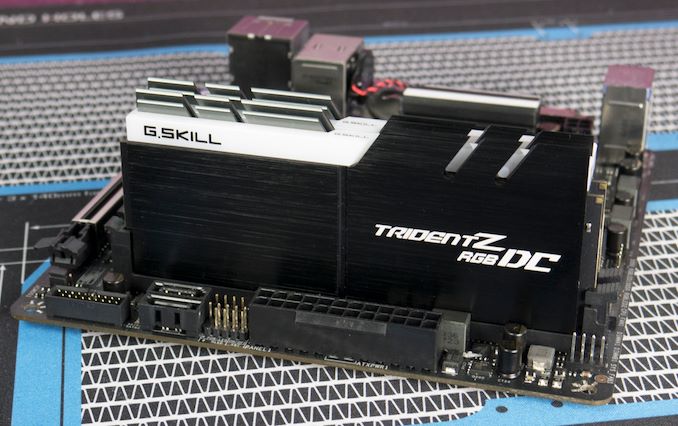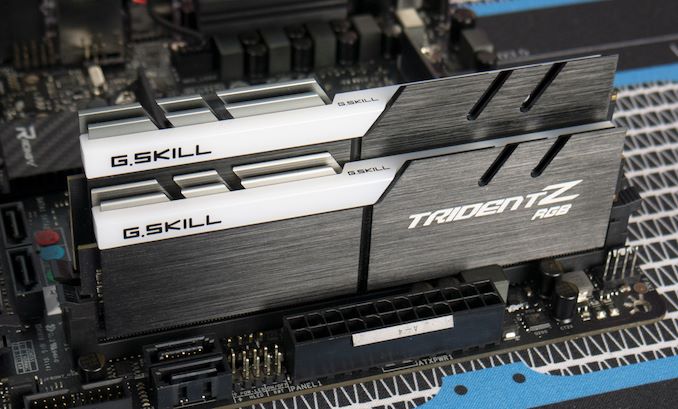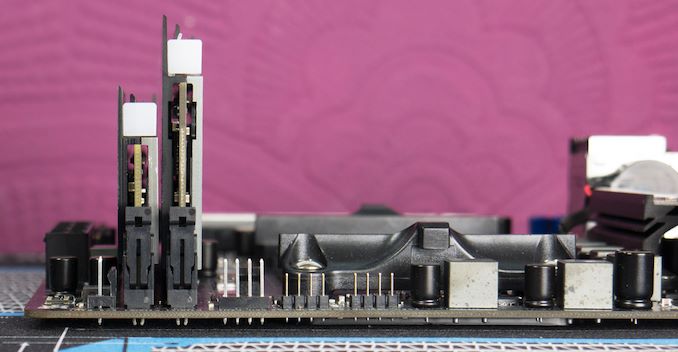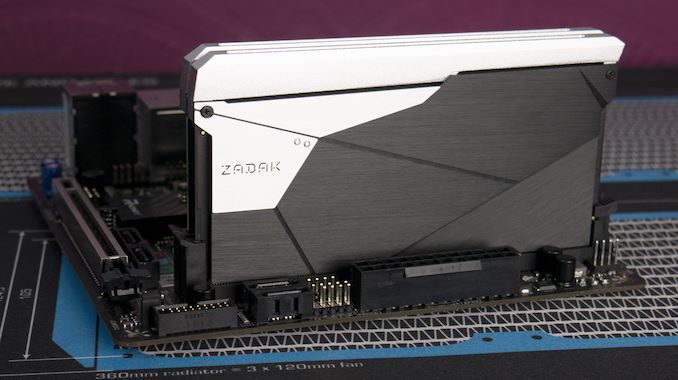In The Lab: Double Capacity 2x32GB DDR4 from G.Skill and ZADAK
by Ian Cutress on November 9, 2018 4:00 PM EST
One of the interesting things to come out of the news in recent weeks is the march to double capacity memory. In today’s market, memory modules for consumer grade computers have a maximum of 16GB per module. This is unbuffered memory, and the standard for home computers and laptops. However recently there have been two major announcements causing that number to double from 16GB to 32GB: Samsung has developed double capacity ICs to drive up to 32GB per module with the same number of chips, but also a couple of DRAM vendors have found a way to put two times as many ICs on a 16GB module to make it up to 32GB. Both G.Skill and ZADAK fall into that latter category, and now we have both of these kits in the lab for review.
Double Capacity DRAM
With memory modules using double the number of chips, the easiest way to enable this is by having taller PCBs. This is exactly what we get.
Here we have G.Skill’s new TridentZ DC RGB memory and a regular module of TridentZ RGB in a motherboard. G.Skill stated that their memory is essentially two UDIMM modules on one PCB, with double chips, double ePROM, and power management. The technical parts involve the pin definitions, the tracing layout, and fine tuning.
This obviously has implications for coolers, with both companies recommending liquid coolers be used to avoid issues with fans not sitting correctly.
The G.Skill TridentZ DC RGB kit is a 2x32GB design running at DDR4-3200 14-14-14, which is a fairly aggressive timing. Price is expected to be rather high.
The ZADAK kit, called ZADAK Shield DC DDR4, runs at similar specifications to the G.Skill kit: 2x32GB running at DDR4-3200 14-16-16. We were told that the price of this kit is going to be nearly USD$1000.
At present, only a trio of Z390 ASUS motherboards are qualified with both memory kits. These are the ASUS ROG Maximus XI Apex, the ROG Maximus XI Gene, and the ASUS Strix Z390-I Gaming. We are awaiting one of these to arrive to begin testing.
At the moment we are looking into what benchmarks we can use to not only differentiate between the kits but also compare them to other memory. Just having double capacity is not enough – we intend to look into power and performance as well. Suggestions are more than welcome!
Related Reading
- G.Skill Unveils 32 GB Trident Z RGB DC DDR4: Double Height, Double Capacity Memory
- Double Height, Double Capacity DDR4? ZADAK's New 32 GB UDIMMs
- Intel to Support 128GB of DDR4 on Core 9th Gen Desktop Processors
- Samsung Adds 32 GB UDIMMs to Memory Lineup
- Samsung Shows Off 256 GB DDR4 RDIMM: Coming to Servers Soon




















17 Comments
View All Comments
Another IT Guy - Friday, November 9, 2018 - link
About 13 years ago, I was assembling some Xeon servers we had purchased from IBM (think xSeries 365 or so) and bought some dual-rank RAM to fill them out. I don't recall the exact number but only a portion of the memory worked and IBM explained that their BIOS addressed the memory by addressable chip, and we had simply put more chips in the slots than they had available. It wasn't documented, and they worked with our memory rep to replace the (of course) non-refundable RAM. Probably not an issue for our desktops, but I would be concerned with higher memory counts like you'd find with people trying to build virtualization hosts.alacard - Friday, November 9, 2018 - link
I have the same kit with 16GB modules: 64GB DDR4 3200@14-14-14 with a Row Refresh Cycle Time @ 560 with a command rate of 2T.5 Questions:
1) What is the Row Refresh Cycle Time for this kit. (I may be a complete idiot here, but I suspect the tRFC is where RAM producers mask their latency in order to get better numbers in the big three Madison Avenue metrics [CL, tRCD, & tRP])
2) What is the voltage.
3) What is the latency and bandwidth compared to 4x16GB of the same amount of memory rated at these speeds.
4) What is the latency and bandwidth @ 4x32GB for both samples.
5) What is the command rate of the 32GB modules.
kpb321 - Friday, November 9, 2018 - link
I don't think 4x32 is possible with these. If you look up the supported MBs they are all limited to 2 slots with only 1 DPC.With the article saying "essentially two UDIMM modules on one PCB, with double chips, double ePROM" I take that to mean that these boards will see it as 1 DPC when one of these is installed. None of the consumer chips support more than 2 DPC so should not allow you to do 4X32 because it would see it as 4 DPC.
kpb321 - Friday, November 9, 2018 - link
**will see it as 2 DPC when one of these is installedyuhong - Friday, November 9, 2018 - link
The 16Gbit DDR4 based DIMMs should also be easier to find this month.dwzl - Friday, November 9, 2018 - link
How does one buy these?CheapSushi - Friday, November 9, 2018 - link
Honestly like how tall these are. It kind of aesthetically balances out the rest of the system since cards in the PCIe slots tend to be might taller, not even usually half-height either. Of course as mentioned it might not fit with certain coolers. But I do like this soluation. It probably ends up cheaper per DIMM to double up the ICs rather than getting the newer higher capacity IC. I know most will say they don't need the RAM but for my multi-use system, I found lots of ways to make use of my 64GB of RAM.PeachNCream - Saturday, November 10, 2018 - link
This reminds me of double stacking DIPs in order to get twice as much RAM when pre 30-pin SIMM motherboards couldn't support enough for newer programs. Combine that with an ISA RAM card and you could get an ungodly amount of system memory - up to the 16MB limit on 80286 CPUs.DigitalFreak - Saturday, November 10, 2018 - link
Seems like a pretty limited market. Any motherboard larger than mini-ITX should have 4 DIMM slots anyway.CheapSushi - Sunday, November 11, 2018 - link
I'd want them even on ATX or EATX. I just like the tall RAM.